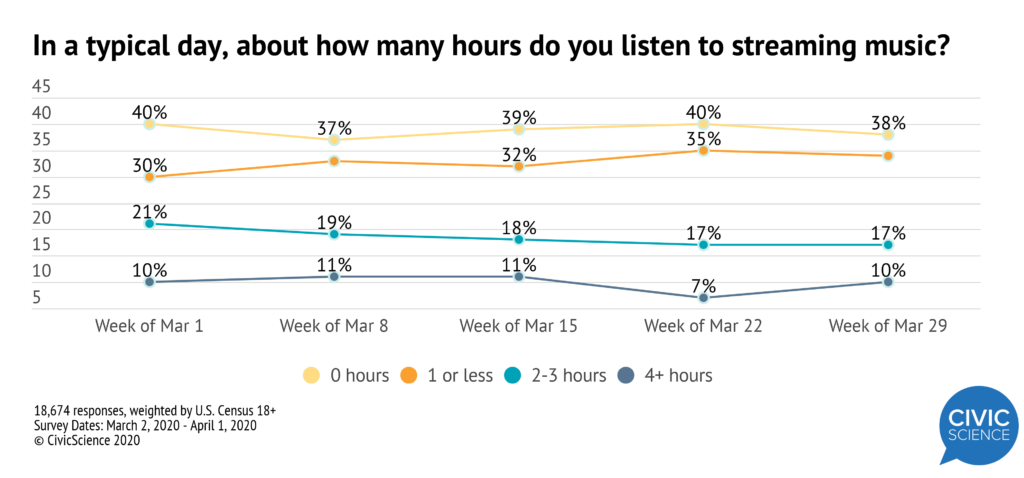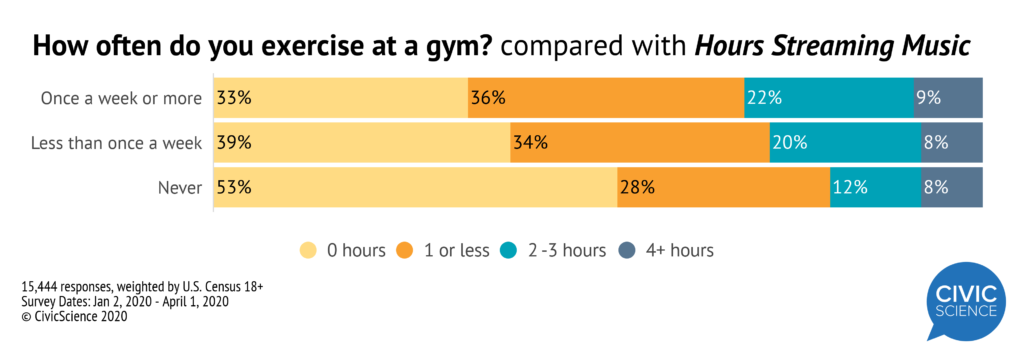As millions of Americans hunker down to prevent the spread of coronavirus, they’re turning to familiar tools for passing the time. There’s been a noticeable surge in video streaming and online gaming subscriptions. These modes of entertainment, along with teleconferencing apps like Zoom are putting palpable strain on internet providers around the world. Despite the heightened activity for bandwidth-gobbling services, people are surprisingly streaming music less under quarantine than they were before the middle of March.
Earlier this month, Quartz reported that the top 200 Spotify singles were seeing sharp declines in countries most affected by COVID-19 outbreaks. Along with album sales hitting a record low, Rolling Stone’s data provider noticed dips across all services, including programmed streamers like Pandora. In addition to countless losses in touring revenue, artists and labels also have to contend with a decline in overall music consumption.
CivicScience surveyed more than 200,000 consumers on their streaming habits. Although streaming has become the preferred method to hear new releases, 41% of adults rarely or never listen to streaming services. About a quarter of Americans lean on free streaming plans, with ads or where they can’t pick specific songs. And 17% of adults are mostly listening to music from paid streaming services, like Spotify or Apple Music. When looking at time spent daily, the data show that on average 39% of consumers spend 0 hours a week listening to streaming services. While the number of adults who listen for an hour per day has spiked a bit, the figures for 2-4+ hours have declined since the beginning of March with little fluctuation week-over-week.
When looking at time spent daily, the data show that on average 39% of consumers spend 0 hours a week listening to streaming services. While the number of adults who listen for an hour per day has spiked a bit, the figures for 2-4+ hours have declined since the beginning of March with little fluctuation week-over-week. It seems somewhat counter-intuitive that music streaming would decline as much of the country stays indoors, but music listening habits are not just largely solitary, they are a stopgap activity for many. Streaming often functions as a soundtrack to commutes, gym routines, office tasks, and more.
It seems somewhat counter-intuitive that music streaming would decline as much of the country stays indoors, but music listening habits are not just largely solitary, they are a stopgap activity for many. Streaming often functions as a soundtrack to commutes, gym routines, office tasks, and more.
For example, CivicScience data show that the more often someone exercises at a gym, the more likely they are to use streaming music services. Given how much has changed in just 30 days – those who “never” exercise at a gym increased by 12% – it is no surprise to see music streaming decrease. Even regular gym goers have seen a downward trajectory in the last month, likely making a difference in the overall decline of music streaming.
Given how much has changed in just 30 days – those who “never” exercise at a gym increased by 12% – it is no surprise to see music streaming decrease. Even regular gym goers have seen a downward trajectory in the last month, likely making a difference in the overall decline of music streaming.
With those opportunities to fit in quiet listening now competing with roommates, families, and the temptation to stream video or game around the clock, it’s only natural for casual music streaming to take a backseat.








